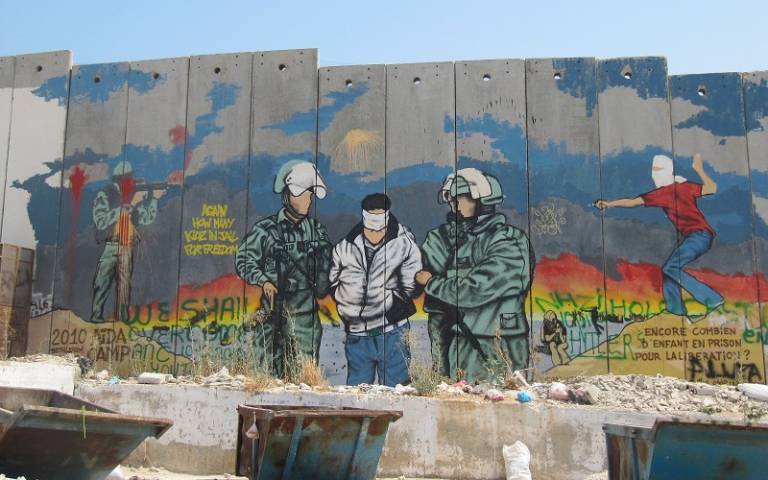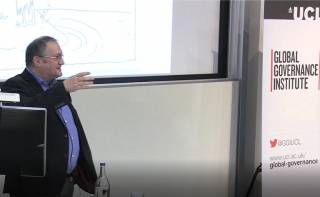Reconstructing Borders in an Era of Globalization
3 March 2017
Tsz Ching Kwok (MSc Gobal Governance and Ethics) on the GGI keynote lecture with Professor David Newman.

From the fall of the Iron Curtain to the rapid expansion of the European Union - over the past two decades, we have seen the widespread opening and removal of borders. However, with major recent events, such as Brexit and the United States' presidential elections, the borderless world discourse has been challenged by discussions on securitization. In many countries across the West, governments are reassessing their border policies to prevent the "threat" of illegal migrants and terrorism.
How do we then study and understand the significance and functions of borders and boundaries in an era of ever-increasing globalization? At a recent Global Governance Institute (GGI) lecture, David Newman suggested that the free flow of information is key. Whether from the perspective of citizens or governments, the lack of information and knowledge is what drives fear and fuels the securitization discourse. Newman, a former editor of the International Journal of Geopolitics, is a professor in the Department of Politics and Government at Ben-Gurion University in Israel.
Globalization and the borderless world discourse
Throughout the lecture, Newman presented numerous caricatures relating to the study of borders. He began with the simplest one: two people are standing on a small deserted island, talking over a fence erected between them. This caricature allows for two different interpretations. Firstly, one could argue that it illustrates the "genetic" nature of humans, how they view territory and have the need to mark it even if space is limited. On the other hand, the caricature could also depict two people who did not like each other initially, but are now beginning peace negotiations across the fence. Maybe, if we were to return to this caricature in the future, the fence would no longer be there.
Much like this caricature, Newman explained, borders have inspired two parallel discourses. The first is the borderless world discourse which began in the 1980s and -90s and gave birth to the renaissance of border studies. With increased globalization, the fall of the Berlin Wall and the expansion of the European Union, the world moved into an era where borders were not just opening up, but sometimes disappearing. There has also been an ideological dimension to this debate, insinuating that a world without borders is a "good" world and should be promoted.
Post 9/11 and the securitization discourse
The second discourse on securitization, which emerged after the 11 September terrorist attacks, suggests that the opening up of borders has amplified security threats. This past year has seen the climax of this discourse, with President Trump's plans of building a wall on the Mexican border, Brexit and the fear of immigrants taking British jobs, and heightened tensions between Israelis and Palestinians that make a two-state solution increasingly difficult.
In a world of ever-increasing globalization, societies and countries have found the need to reconstruct the borders they have previously opened up. However, we need to recognize that globalization does not disappear - people, goods and information will continue to cross borders. Therefore, we now need to understand how societies and countries, notably in North America and Western Europe, can negotiate the two parallel discourses on borders simultaneously.
The strong comeback of borders
Whilst borders can be understood as simple constructs, they are not simple at all. It is not a matter of taking out a map and drawing borders and boundaries to prevent movement, entry and to exclude. In the era of globalization, information and technology but also instability and terrorist threats transcend physical borders. Newman used the example of the 7 July London bombings, where the question of how the terrorists got into Britain in the first place was raised. It turned out they were born and bred in Britain and received most of their technological knowledge through the Internet.
Borders in the globalized world are more complex than ever before. They represent more than just the notion of sovereign Westphalian states. Newman argued that it is much easier to sell the securitization discourse than the globalization discourse. Although the reconstruction of borders is not an actual solution to threats such as terrorism, the idea that building a physical wall or fence could or would stop someone from planting a bomb is more attractive than what the borderless world discourse seems to suggest, namely doing nothing at all.
Peeking over the Wall
Newman concluded by mentioning a short video called Peeking over the Wall, a project which tries to understand what borders mean for younger generations today. They interviewed Israeli and Palestinian children from the ages 9-12 living in the heart of the West Bank to find out what the separation wall has done for them in the last ten years.
In both cases, the youths had mirror images of the group on the other side. Although both groups were educated and used the Internet, they had more polarized negative perceptions of the other side than their parents. Whilst the dissemination of information via social media and the news should, in theory, enable the free flow of both positive and negative information, this particular physical border has heavily impacted the way young people view the other, reinforcing the effect of negative information.
Newman therefore argued that borders themselves do not provide security. Rather, the lack of knowledge and invisibility of the other side is what creates fear. Even where borders might be physically disappearing and become invisible, they are still there. The concept of borders goes beyond physical fences and walls, it also defines our identity and belonging. Therefore, borders change in a globalized world, but they do not disappear. We cannot simply dismiss borders, but we must try to reevaluate their significance and functions.
 Close
Close


